|
|
10 MON - ORANGE BELT
|
|
Here you will find all the information that you will need to prepare you for your grading. This information includes your theory and your practical test. I hope this information helps in giving you a better understanding about Kyokushin Karate and also in giving you a better understanding of your requirements and at the same time it will helps you to study and prepare for your upcoming test. Let Sensei know two weeks in advance if you want to test in other date than the regular testing date.
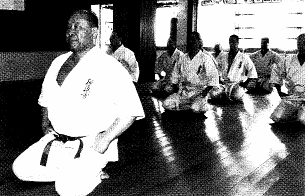
MEANING OF THE BELTS
Below you will find a possible interpretation of the symbolism of the belt colors. I hope this will give a further understanding of the meaning of the Obi (belts) colors. Belt colors are not only to reflect growth in technique, but also in character.
The Orange
Belt (Stability)
At this level, the orange belt
represents the stability that we should bring to our training as well as in our life. On
this level you will begin developing a sense of balance and coordination between
the various parts of your body, with an emphasis to perform your stances
correctly. At this level the students will be given an emphasis to the correct
execution of the Kihon Geiko. Learning the correct way of executing the
techniques will give the students a good foundation that will give them a
cutting edge at later stages of his learning process of the Martial Arts.
Learning to execute the different techniques correctly will require from the
students a lot of work and many repetitions of those techniques. The student must
have a constant devotion in order to persevere and continue training with
receptivity and dedication.
![]()
WHAT YOU SHOULD KNOW FOR YOUR
KYOKUSHIN WRITING TEST
10 KYU - ORANGE BELT
Important Note: To do your Writing Test you must bring a pencil, eraser, and a sharpener.
Below are some vocabulary you should know in order to do your grading.
|
vocabulary 10 |
|||
|
1 |
2 |
||
|
Name |
Meaning |
Name |
Meaning |
| Ago Chusoku Do Fudo Dachi Gi Geri (Keri) Hidari Karate Karate Do Kata Kancho Kumite Kyoku Shin Kai Kyokushinkai Mae Mae Geri Mae Geri Chudan |
Chin or Jaw Ball of foot Path, Way Preparedness or Attention stance Karate uniform Kick Left Empty hand The way of Karate Form/Formal exercise director or President of the organization Sparring Ultimate Truth or Reality To meet/Join/Associate/Society/School Ultimate truth Front, Forward Front Kick Middle front kick |
Nogare Mawatte Migi Morote Seiken Ago Uchi Seiken Jodan Morote Tsuki Seiken Chudan Morote Tsuki Seiken Gedan Morote Tsuki Seiken Sensei Shihan Soto Soto Uke Tsuki Yoi Yoi Dachi (Heiko Dachi) Sanchin Dachi Kumite Dachi Zenkutsu Dachi Uchi |
Calm, Controlled
breathing Turn Right Double, Reinforced Punch to the chin Double high punch Double middle punch Double lower punch Fist Teacher (3rd-4th) Expert (5th Dan above) Outside Outside Block Strike / Punch Ready Ready stance Pigeon toed stance Sparring stance Forward or Front stance Inside / Strike |
YOU SHOULD HAVE A BASIC UNDERSTANDING OF: (Click on the links to get more information on the subject)
|
Karate : Empty Hand | |
|
Karate Do : The way of Karate | |
|
Kyokushinkai : Society or association for the Ultimate Truth | |
|
Kata: Form / Formal exercise | |
|
Kiai! : Explosive / Primal Hara Scream | |
|
Floor Cleaning :
There are many reasons why we clean the floor, below are some of those
reasons; | |
|
Black Belt Titles:
There are 3 Black belts titles you should be aware of, "Sensei", "Shihan",
"Kancho". Those are the more common and the more used in Kyokushin Karate.
Below you will find more information about these tiles. Read them and be
sure you learn how to use it, as it is an important part in the Dojo
Etiquette.
| |
|
Sensei :
Sensei means Teacher and it is used as a general title of respect. Only black
belts with 3rd. Dan (Shodan) and 4th. Dan (Yondan) may use this title. Sometimes, in some schools
when there are no other higher belt than 2nd Dan in charge of the Dojo, the
the students call him Sensei, but it is not appropriate. | |
|
Why do you think our training hall is called “Dojo Entheos” | |
![]()
KIHON KATA
NI:
1) Middle Block (Chudan Soto Uke).
2) Middle Punch (Chudan Tsuki).
3) Front or Forward Position (Zenkutsu Dachi). All the blocks and punches are
done in Zenkutso Dachi.
4) Turning (Mawatte)
KIHON KATA
SAN:
1) High Block (Jodan Uke).
2) High Punch (Gedan
Tsuki).
3) Front or Forward Position (Zenkutsu Dachi). All the blocks and punches are
done in Zenkutso Dachi.
4) Turning (Mawatte)
TAIKYOKU SONO ICHI(OMOTE):
|
KATA TAIKYOKU SONO ICHI |
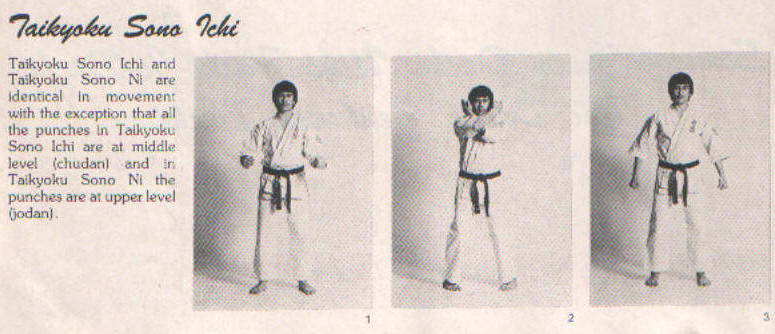 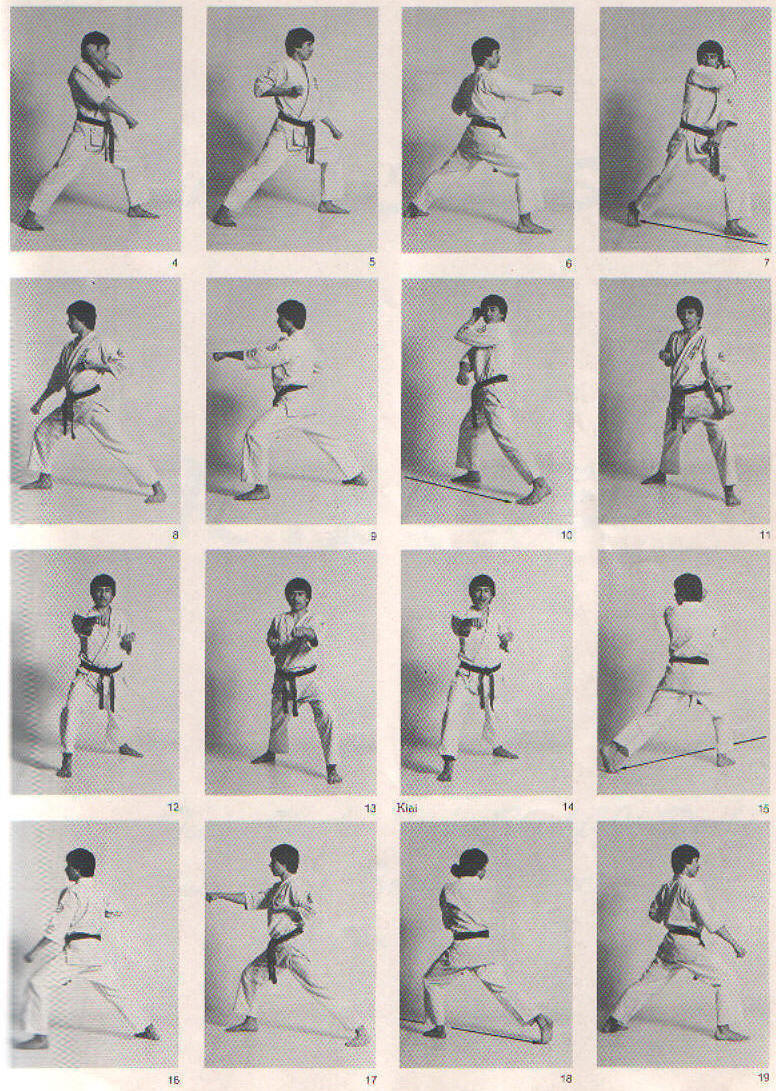  |
Written Step-By-Step Instructions for Kyokushin Karate Kata Taikyoku Sono Ichi:
N= North W= West E= East S= South
N
W E
S
| Ready position (yoi dachi, facing South) | |
| Turn left 90 degrees into left front stance (hidari zenkutso dachi), right low block (hidari gedan barai) (toward East on this case, depending on how you are positioning) | |
| Step forward into right front stance (migi zenkutso dachi), right middle punch (migi seiken oi chudan tsuki) | |
| Turn right 180 degrees into right front stance (zenkutso dachi), right low block (hidari gedan barai) (toward West on this case, depending on how you are positioning) | |
| Step forward into left front stance (hidari zenkutso dachi), left middle punch (hidari seiken oi chudan tsuki) | |
| Turn left 90 degrees, left front stance (hidari zenkutso dachi) with left low block (hidari seiken gedan barai) (do this movement by changing direction to the centerline, toward South on this case, depending on how you are positioning) | |
| Step forward into right front stance (migi zenkutso dachi), middle punch (migi seiken oi chudan tsuki) | |
| Step forward into left front stance (hidari zenkutso dachi), left middle punch (hidari seiken oi chudan tsuki) | |
| Step forward into right front stance (migi zenkutso dachi), middle punch (migi seiken oi chudan tsuki), yell KIAI | |
| Turn left 90 degrees, left front stance (hidari zenkutso dachi) with left low block (hidari seiken gedan barai) (toward West on this case, depending on how you are positioning) | |
| Step forward into right front stance (migi zenkutso dachi), right middle punch (migi seiken oi chudan tsuki) | |
| Turn right 180 degrees into right front stance (zenkutso dachi), right low block (hidari gedan barai) (toward East on this case, depending on how you are positioning) | |
| Step forward into left front stance (hidari zenkutso dachi), left middle punch (hidari seiken oi chudan tsuki) | |
| Turn left 90 degrees, left front stance (hidari zenkutso dachi) with left low block (hidari seiken gedan barai) (do this movement by changing direction to the centerline, toward South on this case, depending on how you are positioning) | |
| Step forward into right front stance (migi zenkutso dachi), middle punch (migi seiken oi chudan tsuki) | |
| Step forward into left front stance (hidari zenkutso dachi), left middle punch (hidari seiken oi chudan tsuki) | |
| Step forward into right front stance (migi zenkutso dachi), middle punch (migi seiken oi chudan tsuki), yell KIAI | |
| Turn left 90 degrees, left front stance (hidari zenkutso dachi) with left low block (hidari seiken gedan barai) (toward West on this case, depending on how you are positioning) | |
| Step forward into right front stance (migi zenkutso dachi), right middle punch (migi seiken oi chudan tsuki) | |
| Turn right 180 degrees into right front stance (zenkutso dachi), right low block (hidari gedan barai) (toward East on this case, depending on how you are positioning) | |
| Step forward into left front stance (hidari zenkutso dachi), left middle punch (hidari seiken oi chudan tsuki) | |
| Return to ready position (yoi dachi, facing South) |
![]()
Below you will find all what you need to know for your grading. It was designed to supply the students with information about their requirements for their grades. If you have any question regarding the requirements consult your teacher. The grading requirements in our school contain the following:
10th MON - (ORANGE BELT):
NOTE: Please keep in mind that the students must pay the testing fees ($20) 2 weeks before they give the writing test. the testing fees cover the cost of the Belt and certificate.
Time in Classes= 7 months (One class per week/90
minutes class)
= 3.5 months (Two class per week/90 minutes class)
= 2 months (Three class per week/90
minutes class)
Theory: You may be required to answer some theory
questions related with your requirements at the practical test.
|
20 Hands Push Ups | |
|
5 Knuckle Push Ups | |
|
20 Deep Knee Bends With Front Kick | |
|
15 Sit Ups | |
|
50 Jumping Jacks or 2 Min. Jump Rope |
|
Zenkutsu Dachi Mawatte (Turn around on Forward leaning stance) | |
|
Zenkutsu Dachi Naore (From Forward leaning stance return to Original Position) | |
|
Kumite Dachi (Fighting stance) |
Zenkutsu Dachi Mawatte:
Move your back leg 2
shoulders widths in length in a straight line. Pivot on the balls of your feet
and turn 180°
to complete the movement.
Zenkutsu Dachi
Naore:
Move your back leg towards your front leg until your feet are touching, at
the same time move your hands across your chest and move your back foot out into
Fudo Dachi)
2) Tsuki Waza: (Punches - Strikes)
|
Seiken Jodan Gyaku Tsuki (Reverse high punch) | |
|
Seiken Gedan Gyaku Tsuki (Reverse low punch) | |
|
Seiken Chudan Morote Tsuki (Double Lunge middle punch) | |
|
Seiken Gedan Morote Tsuki (Double Lunge low punch) |
|
Mae Geri Chudan Chusoku (Middle front kick, using the ball of the foot) |
|
Kihon Kata Ichi (Gedan Barai/Jodan Tsuki) | |
|
Kihon Kata Ni (Chudan Uke/Chudan Tsuki) | |
|
Kihon San (Jodan Uke/Gedan Tsuki) | |
|
Taikyoku Sono Ichi |
6) Idogeiko: (Basic Moving)
|
Seiken Jodan Oi Tsuki (Going forward in Zenkutsu Dachi) | |
|
Seiken Chudan Oi Tsuki (Going forward in Zenkutsu Dachi) | |
|
Seiken Gedan Oi Tsuki (Going
forward in Zenkutsu Dachi) | |
|
Seiken Jodan Gyaku Tsuki (Going forward in Zenkutsu Dachi) | |
|
Seiken Chudan Gyaku Tsuki (Going forward in Zenkutsu Dachi) | |
|
Seiken Gedan
Gyaku Tsuki (Going forward in Zenkutsu Dachi) | |
|
Seiken Jodan Uke (Going forward in Zenkutsu Dachi) | |
|
Seiken Chudan Uchi-Uke (Going forward in Zenkutsu Dachi) | |
|
Seiken Gedan Uke (Going
forward in Zenkutsu Dachi) | |
|
Hiza Geri (Going forward in Zenkutsu Dachi) | |
|
Kin Geri (Going forward in Zenkutsu Dachi) | |
|
Mae Geri (Going
forward in Zenkutsu Dachi) | |
|
Seiken Jodan Morote Tsuki (Going forward in Zenkutsu Dachi) | |
|
Seiken Chudan Morote Tsuki (Going forward in Zenkutsu Dachi) | |
|
Seiken Gedan Morote Tsuki (Going
forward in Zenkutsu Dachi) |
![]()
FUDO DACHI: Stand with your feet turned outwards
, approximately one shoulder width apart and your weight evenly
distributed. Hold your arms in front of you, fists clenched with the
elbows kept close to the side of your body.
|
|
|
| ZENKUTSO DACHI: About 70% of your weight is on
your front leg and 30% on your back leg. Your front leg is pointing
straight ahead with your knee over the center of your foot. Your back
foot is at an angle of 45° and your back leg is
straight. The feet are shoulder wide, and the rear foot is approximately
two shoulders back
|
|
|
|
 |
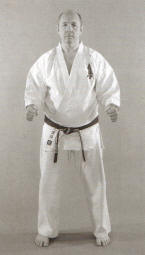 |
|
Turn your heels out and at the same time move your hands upwards across your chest. |
Slowly pull your hands down and turn your heels inwards until your feet are parallel |
|
|
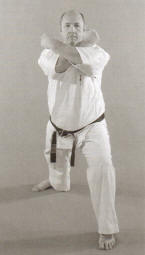 |
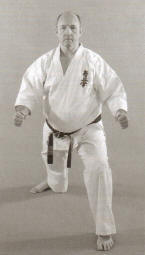 |
 |
|
Step back with your right leg so your feet are approximately one shoulder width apart and two shoulders in length. Crossed your arms in front of you |
Complete the hands movement by uncrossed your arms and finishing with Seiken Morote Gedan Barai |
Zenkutsu Dachi: Side view |
ZENKUTSU DACHI MAWATTE
(TURNING IN ZENKUTSU DACHI)
|
|
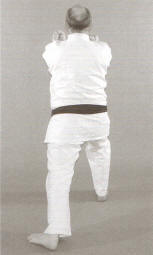 |
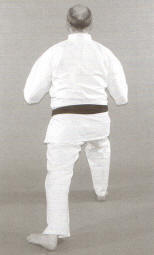 |
|
Move your back leg two shoulders widths in length in a straight line. |
Pivot on the balls of your feet and turn 180° to complete the movement. |
Complete the hands movement with Seiken Morote Gedan Barai |
|
|
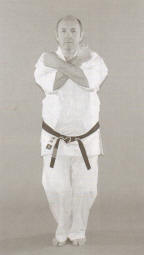 |
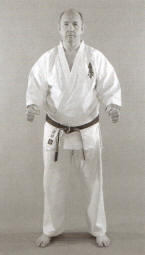 |
|
Move your back leg towards your front leg until your feet are touching, at the same time move your hands upwards across your chest |
Slowly pull your hands down and move your right foot out into Fudo Dachi. |
|
|
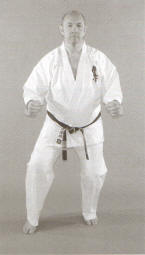 |
 |
|
Back
View: |
STRIKES WITH THE FRONT OF THE FIST
(SEIKEN)
|
|
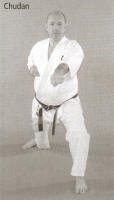 |
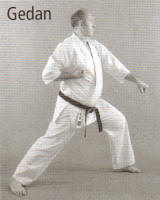 |
|
Seiken Jodan Oi Tsuki |
Seiken Chudan Oi Tsuki |
Seiken Gedan Oi Tsuki |
|
SEIKEN MOROTE TSUKI |
||
|
|
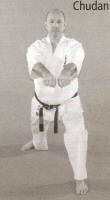 |
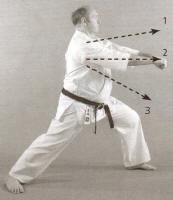 |
|
Seiken Morote Chudan Tsuki |
1: Morote Jodan Tsuki |
|
|
SEIKEN JODAN UKE |
APPLICATION |
||
|
|
|
|
|
|
SEIKEN CHUDAN SOTO UKE |
APPLICATION |
|||
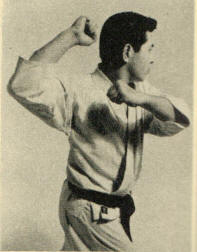 |
|
|
|
|
|
SEIKEN GEDAN BARAI |
APPLICATION |
|||
|
|
|
|
|
|
| HIZA GANMEN GERI |
APPLICATION |
|
|
|
|
|
| KIN GERI |
APPLICATION |
|
|
|
|
|
|
MAE GERI |
APPLICATION |
|
|
|
|
|
The Karate Dogi or Gi is the outfit worn for Karate training. It consists of a jacket (uwagi) and trousers (zubon) made of white cotton or canvas and a belt (obi).
The belt worn indicates the rank of the Karateka according to
the standard ranking system adopted in Kyokushin Karate. The ten lower ranks (Mudansha)
of Kyu or non-black belt holders are divided into the following colors: White,
Orange, Blue, Yellow, Green and Brown. The upper ten ranks (Yudansha) of Dan
have the holders wearing the Black Belt. (See belt
rankings.) Although one washes ones gi, the belt is never washed. Every
class that you take, every drop of sweat, every little tear or abrasion is part
of what goes into each student's unique experience. It is something to be
remembered, but not clung to. Therefore no experience is washed away. The belt
must tell its own story.
How to Tie the Obi
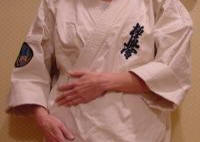 |
 |
 |
| Place the left side of the gi over the right side. | Put the middle of the belt against the navel. | Wrap the belt around the body, from front to back, crossing in the back. |
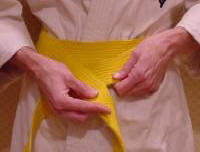 |
 |
 |
| Lay the right end of the belt over the left side. | Bring the right end up behind both layers of the belt wrapped around the body | Cross the left end of the belt over the right, forming a loop |
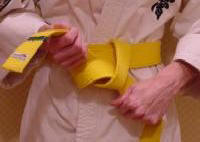 |
 |
 |
| Thread the top end up through the bottom of the loop | Pull tight both sides of the belt at the same time | The finished belt. Both end of the belt should have the same length |
JUNIOR BELT RANKINGS (Mon)
|
|
12 Mon |
Junior White Belt | |||||||
|
11 Mon |
Junior White Belt with Orange stripe | ||||||||
| 10 Mon | Junior Orange Belt | ||||||||
| 9 Mon | Junior Orange Belt with Blue stripe | ||||||||
| 8 Mon | Junior Blue Belt | ||||||||
| 7 Mon | Junior Blue Belt with Yellow stripe | ||||||||
|
|
6 Mon | Junior Yellow Belt | |||||||
| 5 Mon | Junior Yellow Belt with Green stripe | ||||||||
| 4 Mon | Junior Green Belt | ||||||||
| 3 Mon | Junior Green Belt with Brown stripe | ||||||||
| 2 Mon | Junior Brown Belt | ||||||||
| 1 Mon | Junior Brown Belt with Black stripe | ||||||||
| Shodan | Black Belt beginner grade (Senpai grade) | ||||||||
| Nidan | Black Belt 2nd degree (Senpai grade) | ||||||||
| Sandan | Black Belt 3rd degree (Sensei grade) |
The Gi is the traditional uniform of Karate, and its main purpose lies in its
functionality. This applies to all of the Japanese and Okinawan Karate styles.
Judo uniforms are also called Gi. Below are one set of pictures and one set of
drawing that will help you to learn the proper way to fold a Gi.
Place the Gi jacket on the floor, fold your trousers and place them in the center of the jacket. Fold the left side of the jacket and then fold the sleeve back. repeat on the right side. Roll the Gi and put your Belt around it.

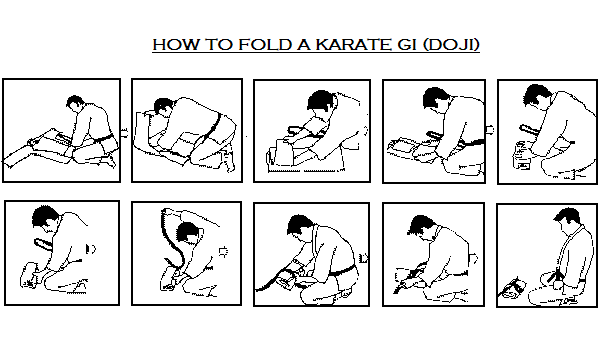
![]()
For more information contact your teacher, sensei Angel Carrasco at 663-8102 or e-mail him at: angel@kyokushincanada.com
GO BACK TO THE INDICES PAGE (REQUIREMENTS)
GO TO THE MAIN PAGE OF WINNIPEG KYOKUSHIN KARATE - DOJO ENTHEOS